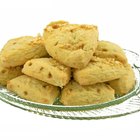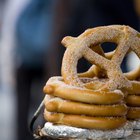
Although many well-known Italian desserts need refrigeration, such as cheesecake and tiramisu, many other Italian specialties can be stored and served at room temperature. Typically a bit less sweet than American desserts, Italian desserts are nonetheless intensely flavorful and satisfying. Gina Depalma, chef at Babbo in New York City, jokes that rum and orange zest make any dessert taste Italian, but you have many other flavors to choose from as well.
Pass the Cookies
Most Italian cookies, whether store-bought or homemade, are safe at room temperature for five to seven days. Biscotti, crunchy twice-baked cookies, come in flavors ranging from chocolate pistachio to cranberry walnut, anise, almond and hazelnut. Other Italian cookies include amaretti, crisp macaroon cookies made with almond paste; strazzate, chocolate-almond cookies; and cartellata, deep-fried cookies either drizzled with honey or sprinkled with lemon zest and cinnamon sugar.
Cakes Bursting With Flavor
Uniced Italian olive oil cake, similar to pound cake, and breadlike fruitcake from the Friulian region of Italy last three to five days at room temperature. Italians frequently flavor olive oil cake with orange zest, candied oranges or orange liqueur, and they pack Friulian fruitcake with an assortment of dried fruits and nuts, including pine nuts, hazelnuts, prunes and figs. Moister Italian sponge cakes, called pan di Spagna, or Spanish bread, last one to three days outside the refrigerator.
Fruitful Choices
As in many cultures, Italians appreciate fruit simply served to emphasize its natural flavor. Serve sliced fresh fruit artfully arranged on plates or bowls, perhaps drizzled with honey or fruit-flavored liqueurs. Most fresh fruit keeps for a few days at room temperature prior to slicing it. To enhance the flavor of fresh fruit, sprinkle it with sugar and let it sit for a few minutes before serving. Or macerate the fruit, a process similar to marinating, by letting it soak with sugar and a teaspoon per serving of balsamic vinegar, rum or a flavored liqueur.
Sweet Dreams
Although originating in Switzerland, gianduja, a chocolate-hazelnut paste, appears throughout Italy. You'll find American versions of the paste in grocery stores and Italian or Swiss varieties in specialty food stores. Spread the paste on cookies, create layers in pound cakes or use it as a filling for cannoli. Panforte, an Italian confection, resembles fruitcake, but its minuscule amount of flour and chewy texture make it more a fruity, nutty candy than a cake. You can store both sweets at room temperature.
Related Articles
How to Freeze a Fruitcake

What Is the Difference Between Scones & ...
Can I Eat a Fruitcake From Last Year?

Different Breads From Different ...

Can I Use Raspberry Jelly as Cake ...

Difference Between Peppermint Extract & ...

How to Make Almond Buttercream Frosting

How Long Can a Brandy-Soaked Fruitcake ...

How to Cook Strawberries

How to Store Homemade Fruitcakes

Fruits or Vegetables Starting With X

Can You Make Tiramisu With Margherite ...

What Are Rusk Crumbs?

How to Toast a Baguette

Wedding Rehearsal Dinner Cake Traditions

Desserts to Pair With Cabernet ...
Easy Strawberry Cake Recipe
What Is Rusk Bread?

How to Make Homemade Strawberry Pound ...

Nutrition Facts for Tootsie Rolls
References
- Saveur: 16 Bellissimi Italian Desserts
- The Flavor Bible; Karen Page and Andrew Dornenburg
- The Deluxe Food Lover's Companion; Sharon Tyler Herbst and Ron Herbst
- Food & Wine: Cartellata Cookies
Writer Bio
Susan Lundman began writing about her love of cooking, ingredient choices, menu planning and healthy eating after working for 20 years on children's issues at a nonprofit organization. She has written about food online professionally for ten years on numerous websites, and has provided family and friends with homemade recipes and stories about culinary adventures. Lundman received her M.A. from Stanford University.
Photo Credits
Jupiterimages/Stockbyte/Getty Images